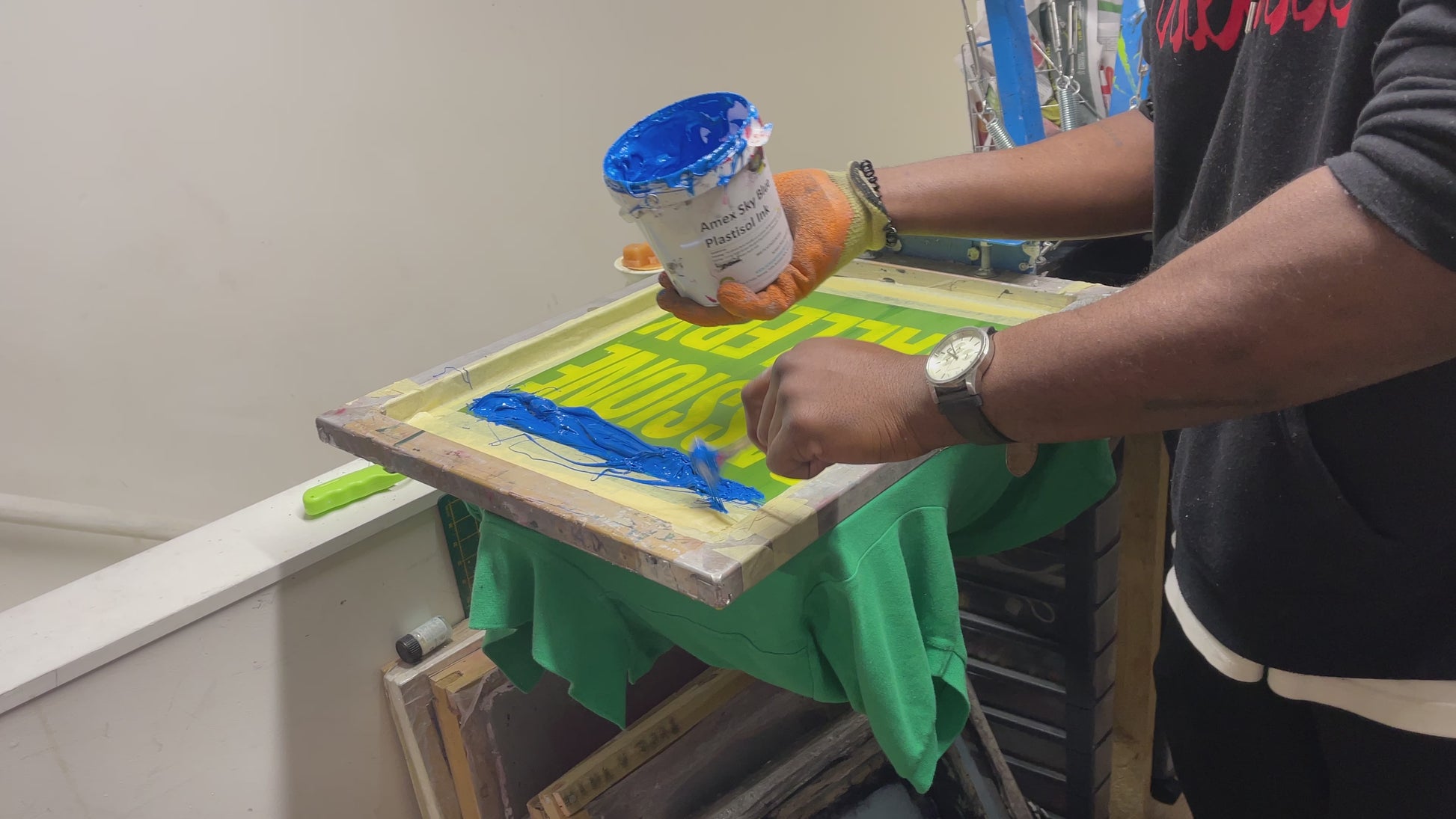Display Printing Uncovered: Whatever You Need to Understand About Tee Shirt and Garment Printing Methods
If you have actually ever before questioned exactly how those vibrant layouts wind up on your favored tee shirts, you remain in the right location. Display printing is a fascinating approach that combines art with technique, offering endless possibilities for creativity. Comprehending the principles, from devices to ink selections, can greatly impact your results. Prepared to explore the crucial elements that make screen printing an art form? Let's discover the information that can raise your jobs.
The Essentials of Screen Printing: Just How It Works
When you plunge into display printing, you'll discover it's both a scientific research and an art. At its core, screen printing involves developing a pattern, or display, that enables ink to travel through just in details areas (screen printing kit). You begin by selecting your style and preparing your screen with a light-sensitive solution. As soon as you reveal this solution to light, it solidifies, leaving your style as an unfavorable room.
Next, you'll mix your inks and prepare your printing surface. Position the display over the fabric, after that use a squeegee to press ink via the display onto the garment. This process requires accuracy, as you want clear, dynamic prints. After printing, you'll treat the ink with warmth, ensuring it complies with the textile and lasts through laundries. Each action is crucial, and grasping them will certainly elevate your screen printing abilities, transforming straightforward garments into unique, meaningful pieces.
Types of Screen Printing Methods
Once you comprehend the basics of screen printing, it's time to check out the various techniques that can elevate your styles. One prominent approach is conventional screen printing, where ink is pushed via a stenciled screen. This method is terrific for bold, lively colors. Then there's water-based ink printing, which supplies a softer feel and is environment-friendly, yet it calls for a different approach to healing.
If you're going for fine details, consider discharge printing. This technique gets rid of color from the textile, leaving a soft, classic look. One more option is plastisol printing, understood for its resilience and vibrant colors, making it a preferred for lots of brands. Experiment with halftone printing to produce gradient effects and intricate layouts. Each method has its unique beauty, so don't hesitate to attempt them out to find what matches your style best!
Important Tools for Screen Printing
To achieve stunning outcomes in screen printing, having the right tools is essential. You'll require a durable display printing frame, which holds the mesh that moves your layout onto the garment. Next, buy high-quality mops; these are essential for applying ink uniformly throughout the screen. You'll likewise need an excellent exposure system to develop your screens, as well as a washout booth for cleansing them after usage. A trustworthy heat source, like a conveyor dryer or warm press, is critical for curing your prints to ensure long life. Don't fail to remember a proper office, equipped with tables and storage space for your materials. Ultimately, safety equipment, such as handwear covers and masks, will certainly maintain you secure from chemicals and inks. With the right devices, you'll be well on your method to producing professional-quality prints.
Choosing the Right Inks and Products
When choosing inks and materials for screen printing, you need to think about the sort of ink that functions ideal for your task. Think of textile compatibility to ensure your styles look last and great lengthy. Additionally, discover environmentally friendly ink choices to make your printing process much more sustainable.
Kinds of Screen Inks
Choosing the appropriate screen ink is essential for attaining vibrant, sturdy prints that satisfy your project's requirements. There are a number of types of display inks to analyze. Specialized inks, such as metal or glow-in-the-dark, can include one-of-a-kind results to your styles.

Fabric Compatibility Factors To Consider
Comprehending material compatibility is vital for attaining premium screen prints, specifically because different materials respond distinctively to numerous inks. Always examine your inks on example fabric to ensure they adhere effectively and preserve shade integrity. In addition, maintain in mind that fabric weight and appearance can affect the last outcome, so choosing the appropriate ink and product combination is important for your job's success.
Eco-Friendly Ink Options
Environment-friendly inks are becoming a popular selection for screen printers who intend to reduce their environmental influence while maintaining top quality. When selecting inks, think about water-based inks, which are less damaging and much easier to cleanse up compared to traditional click solvents. These inks bond well with materials, supplying vivid outcomes without toxic chemicals. You may also explore eco-solvent inks that utilize fewer unpredictable natural substances (VOCs), making them a much safer alternative for both your health and wellness and the world.
Additionally, search for inks made from renewable energies, such as soy or vegetable-based alternatives. By selecting the best inks and materials, you'll not only develop magnificent layouts yet likewise add to a much more lasting printing procedure. Make the button, and your prints will certainly mirror your dedication to the environment!
Preparing Your Layout for Display Printing

Submit Style Needs
To assure your style looks vibrant and sharp on textile, you'll require to pay close interest to file layout requirements for display printing. Make certain your style has a clear history to avoid undesirable white edges on your prints. Keep color modes in mind; CMYK is conventional for screen printing, so transform your RGB makes appropriately.
Shade Splitting Up Methods
Shade separation is a vital action in preparing your layout for display printing, and mastering it can substantially enhance your print quality. You'll need to damage your design right into specific colors, as each shade needs a different screen during printing. This accuracy not only assures accurate color representation but likewise Your Domain Name simplifies the printing procedure.
Resolution and Dimension
Attaining the most effective outcomes in screen printing starts with ensuring your style has the appropriate resolution and size. Preferably, your art work should go to the very least 300 DPI (dots per inch) for sharp, clear prints. Your final item could look pixelated and less than professional. if you make use of lower resolution.
When it comes to size, think about the measurements of your print area. Style your art work to match the final print dimension, ideally developing it in the real measurements you'll be printing. By doing this, you'll avoid any kind of unforeseen scaling concerns.
Always check your layout in both vector and raster layouts. Vector graphics can be scaled without shedding top quality, making them perfect for display printing. Preparing correctly will guarantee your design looks incredible on every garment!
Step-by-Step Screen Printing Process
Screen printing is a vibrant procedure that enables you to create vibrant styles on various surface areas. To get started, you'll require a screen, solution, and your chosen ink. First, prepare your screen by cleansing it completely. Next, use the emulsion evenly and let it dry in a dark area. When completely dry, subject your display to light with your style put on it, which will harden the emulsion where the light hits, producing a stencil - screen printing kit.
After cleaning out the unexposed emulsion, your screen prepares. Establish it up on your printing surface area and straighten your garment beneath it. Pour ink onto the screen and use a squeegee to push the ink with the pattern onto the textile. Raise the display thoroughly and let the print completely dry. Heal the ink making use of warm to guarantee resilience. That's it! You've successfully screen printed your design.
Tips for Effective Display Printing Projects
While you're diving into your screen printing jobs, bear in mind that prep work is crucial to success. Start by gathering all your products-- inks, garments, screens, and mops. A tidy work area aids avoid undesirable errors, so clean up prior to you begin.
Following, verify your art work is high-resolution and effectively sized for your garment. Check your screen for correct direct exposure and clean it extensively to stay clear of spots. When mixing your inks, follow the supplier's guidelines to attain the best uniformity.
During printing, use even stress with your squeegee for consistent outcomes. Do not rush; take your time to confirm each print meets your requirements. After printing, let your garments dry entirely before handling or packaging them.
Last but not least, always maintain a sample of your help future referral. This method, you can assess your development and enhance your strategies in time. Happy printing!

Often Asked Concerns
Exactly how Lengthy Does It Require To Establish a Screen Printing Job?
Establishing Learn More a display printing work usually takes around 30 minutes to an hour. You'll prepare the displays, mix inks, and change the press. The moment differs based upon intricacy and experience, so remain organized!
Can I Print on Various Textile Enters Utilizing the Same Technique?
Yes, you can print on different fabric types using the same technique, however you'll require to readjust your setups and inks. Some fabrics soak up ink in a different way, so experimenting guarantees the ideal outcomes for each and every material.
What Are Common Blunders to Prevent in Screen Printing?
When display printing, prevent common blunders like utilizing the incorrect ink, overlooking correct direct exposure times, or skipping pre-press checks. Constantly evaluate your arrangement and preserve clean displays to ensure quality outcomes each time.
Exactly How Can I Appropriately Clean and Keep My Display Printing Devices?
To appropriately tidy and keep your display printing equipment, you should regularly clean screens with appropriate solvents, inspect squeegees for wear, and assure all tools are saved dry and dust-free. Uniformity improves and avoids pricey repair work efficiency.
Is Display Printing Environmentally Friendly Compared to Various Other Techniques?
Display printing can be extra eco-friendly than other techniques, especially if you utilize water-based inks and eco-conscious products. By selecting lasting supplies and methods, you lower waste and minimize your influence on the earth.
Screen Printing Uncovered: Whatever You Required to Know Concerning T-Shirt and Garment Printing Methods
At its core, display printing involves developing a pattern, or screen, that permits ink to pass with just in certain areas. Position the display over the material, then utilize a squeegee to push ink via the screen onto the garment. One popular method is conventional screen printing, where ink is pressed with a stenciled screen.When choosing inks and materials for display printing, you need to take into account the type of ink that functions ideal for your project.